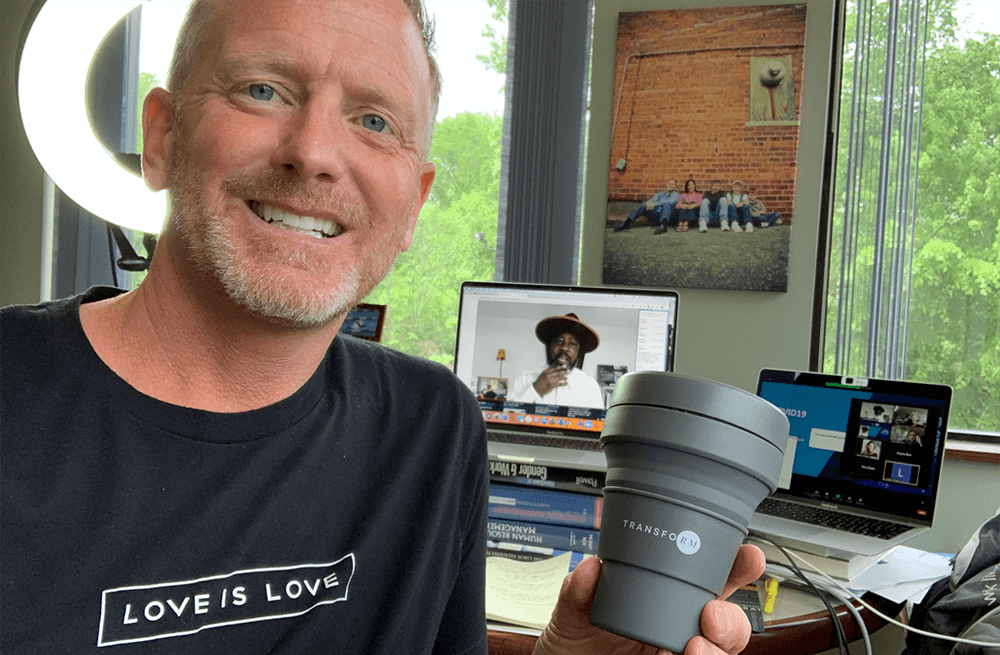
Event emcee Tim Sackett holds a collapsible cup that was part of the experience box participants opened throughout Symphony Talent’s virtual Transform conference.
When talent marketing software and services company Symphony Talent had to move its recruitment marketing conference Transform, scheduled for June 3-4 in Boston, online during the pandemic, organizers were determined not to lose the experiential aspects the company’s in-person events were known for. Aya Estrin, New York City–based Symphony Talent’s director of events and experiential marketing, said a lot of brainstorming went into the question of “what can we do with a virtual event that would really differentiate us and give it that personal touch?”
Their solution? Experience boxes sent to participants’ homes. “When you go to an event, there’s a whole experience with what you see, what you smell, what you taste, what you touch,” Estrin said. “We wanted to try to bring that into people’s homes as they participated in the conference.”
In addition, Estrin and Elyse Mayer, vice president of marketing, wanted to go way beyond the usual swag sent for branding purposes, and make opening and enjoying carefully curated items part of the group’s communal experience.
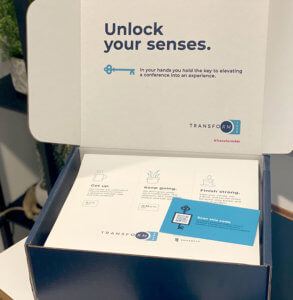
Symphony Talent sent participants and “experience box” filled with program-related goodies they opened throughout the virtual Transform conference.
They approached the boxes with an organizing principle around how the six-hour, daylong program would be broken out — in three blocks of time, each with a theme: “Get Up” for the morning sessions, “Keep Going” for mid-afternoon, and “Finish Strong” for late afternoon/early evening. Then they thought about what items would enhance the participant experience at each stage.
Everything Estrin chose had a charitable component, she said. “I tried to look into companies that were giving back, as well as small, local businesses to bring them attention during COVID, and direct any sort of funds we could to them,” she said.
Initially, they sought out a single-vendor solution, a company that could provide all the pieces and package them in a branded box. But Estrin was disappointed to find only companies that would assemble boxes with swag items and “slap a label on them,” she said. “And that’s not what we were trying to achieve. We wanted to make this part of our Transform brand. It needed to look a certain way. The quality had to be on par with how we treat everything. So being the super control freak that I am, I ended up just taking it on myself and sourcing the boxes. We designed them in house and had them custom printed — everything from the tissue paper to the stickers. And we picked out all the individual items — we did that all internally.”
A Premium Experience
The experience boxes were not automatically sent to all 1,700 Transform registrants. They could be ordered for $99 ($49 for existing Symphony Talent customers) in addition to the $99 event registration fee and were part of an “Insider Experience” ticket, Mayer said. “We were really mysterious about it from a marketing strategy. I don’t know if that was good or bad,” she said, adding that they “probably could have been clearer” about what recipients could expect. They wanted to provide just enough details, she said, to pique interest, without spelling out the boxes’ content. The messaging was that “it’s going to be valuable for the day, not everyone is going to get it, and it’s going to be something that you can keep and continue to use, and the items would be premium. That was about as much as we gave away,” Mayer said. “We tried to just let them know we hand-selected a curated box for the day of the event.”
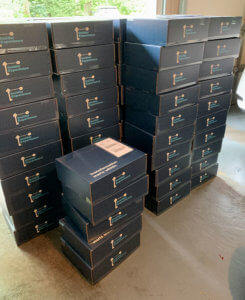
Aya Estrin assembled 150 boxes in her garage.
Estrin and Mayer decided on a total of 150 boxes — which Estrin assembled in her garage.
“We had never done this before,” Mayer said. “Clearly, our stand on this was we’re either going to do it kick ass or we’re not going to do it at all. This is the era of at-home box deliveries, like Stitch Fix,” so they figured there would be an appetite for the initiative, but it was difficult to gauge. “We priced out 150,” Mayer said, which covered costs.
Those who ordered the boxes were instructed not to open them until the day of the conference, when different items would be unveiled at different times during the program. Even the event’s emcee received a box and was told he would be unveiling the contents at the same time as everyone else. “It was very stressful for me and Aya. We wanted to make sure everyone had the boxes a few days in advance,” Mayer said, but would save the opening for the actual event. “People were taking pictures of the box on their doorstep, saying they really wanted to open them and posting on Twitter and LinkedIn,” she said.
“Having the emcee open the boxes with everyone at the same time helped pace everyone so they weren’t tearing through it like on Christmas morning,” she added. “They were waiting for him to guide them. And then it was like a sense of community. This was really something that we wanted people to do together and to see other people doing the same thing.”
Breaking up the Day
Mayer acknowledged that a six-hour online event “is really long,” but the company’s goal was to “keep the original in-person program intact and we had a lot of the speakers locked in. We didn’t really have an option,” she said. “We were concerned. Like, holy cow, who’s going to stay on for six hours?”
So the program was broken up into three two- hour segments “with breaks peppered in,” Estrin said. The boxes would help to set the tone for each segment. “We really wanted to say, if someone wants to just join for two hours in the morning, they could be a part of it with everyone,” Mayer said. “They would see the unboxing. They’d have some awesome items, even if they wanted to skip the morning, but join in the afternoon. We had these two-hour segments where it felt like a complete little conference instead of people being like,
‘Oh man, they [opened] everything in the beginning and I couldn’t join until the end and I missed it.’ We really tried to make sure that during any segment of the day, you could experience what the conference was bringing.”
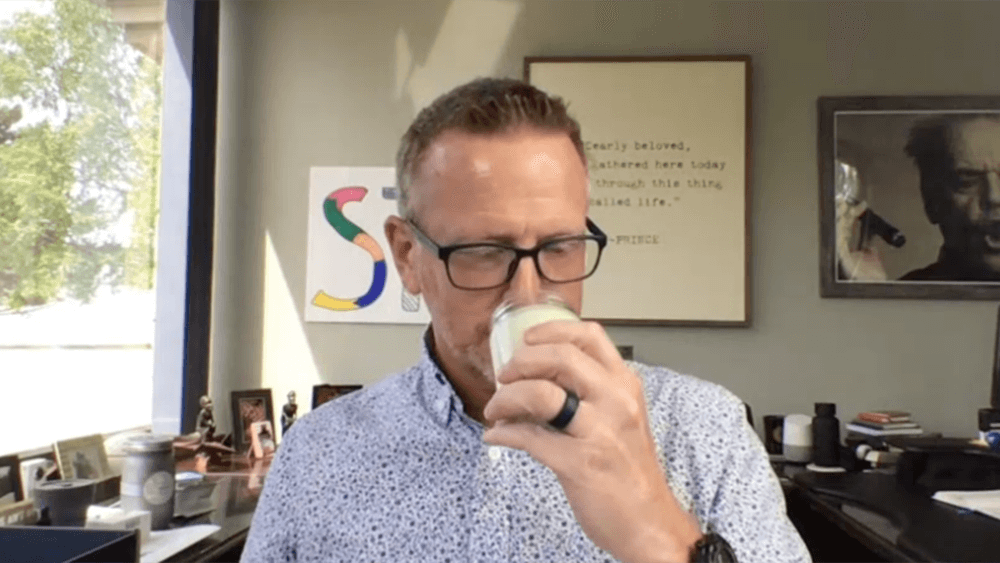
Emcee Tim Sackett smells a candle included in the Transform experience box to be used during a section called the Fireside Chat. The scented candle, with a wooden wick that crackled like burning logs, smelled like a fireplace.
What Was Inside
The program’s “bonus breaks,” Estrin said, included a guided meditation session in the morning, a chair stretch in the middle of the day, and a mixology session at the end. Keeping those things in mind, Estrin thought about what could be put in the boxes to make all of those experiences come to life.
For the “Get Up” morning segment, participants opened a bag of coffee beans from a Hoboken, New Jersey–based coffee shop, bwé kafe, which partners with a Haitian charity, along with a collapsible coffee cup to get caffeinated, and a pair of Bombas socks (which donates a pair of socks to those in need for every pair purchased) to get comfortable. There was an essential oil made by their meditation expert, who showed everyone how to use the oil before she guided them through a five-minute meditation. “People loved that,” Mayer said. “They loved starting the day with it all about getting your mind right.”
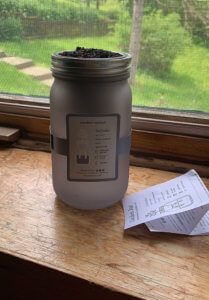
The boxes included a Modern Sprout plant that could be grown in a glass jar. It went with the event’s overall theme of growth.
For each collapsible coffee cup Symphony Talent purchased, one was donated to an essential worker during the pandemic, and along with the bag of beans, experience box recipients got a card telling them how they could gift a bag to a friend for free.
For “Keep Going” in the afternoon, the mid-section of the box contained a bag of popcorn, a plant that could be grown in a Mason jar that went with the event’s overall theme of growth, a CBD balm for the stretching exercise, and a notebook that uses recycled paper.
For the closing keynote for the “Finish Strong” segment, Mayer interviewed First Lady Michelle Obama’s chief speechwriter. The discussion was called a Fireside Chat, to be paired with a scented candle with a wooden wick that participants could light that crackled and smelled like they were sitting by a fireplace. The afternoon items also included a glow necklace and bracelet for the DJ segment, Cookies for Kids’ Cancer for an afternoon treat, and a ginger syrup for the mixologist’s session, who made a custom drink called “The Zoom Call.”
The experience boxes were “a prototype — we wanted to see how it would be received,” Mayer said. “And people went nuts over them.” Estrin and Mayer received numerous emails from those who received the boxes about how much they enjoyed them as well as messages from those who regretted not making that part of their experience, asking if there were still any available for purchase.
“It was hard to scale this, and we’ll have to figure out,” Mayer said, how to plan for experience boxes for the next Transform event, which may be a hybrid. But the boxes, she said, “will 100 percent become a staple of the Transform experience.”
Michelle Russell is editor in chief of Convene.
